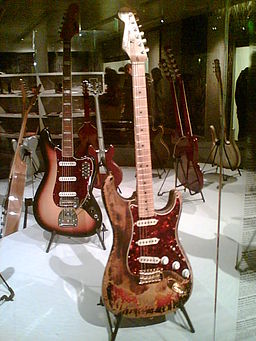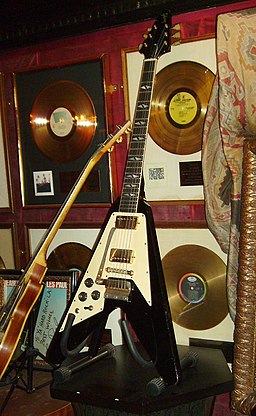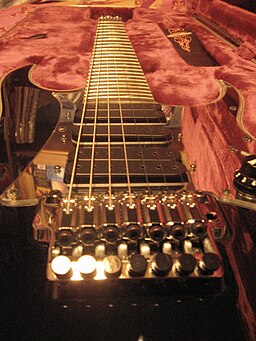People are always asking me about Guitars. I don't mind as I love them and would gladly chat about these fine instruments all day but the one thing that does bug me as a guitar player is when someone wants to buy a guitar and then says, "I just want a cheap one for now to learn on". O.K well this may just sound like common sense to some but I am not going to let that stand in the way of my giving an opinion. Most people who have approached me have a budget of around £100 or so to buy their first guitar and that's fine...as a deposit! "Truthfully" I tell them, "You are not going to get a guitar worth learning on for that price!".
I can honestly say that I am not being stuck up here without a hint of sarcasm. It is the unfortunate truth! £100 will not get you a guitar worth learning on unless you are very lucky and manage to find a decent quality second-hand instrument for around that price. Mass produced guitars from the Far East saturate music shop shelves everywhere these days and even American and European brands are made there to save the brands money. But that is not me saying that all instruments made there are of poor quality. Brands like Yamaha are excellent quality manufacturers of all kinds of musical instruments for example. However, it is my belief that if you are thinking about buying your first guitar you should be thinking of paying around £350 to £500. I just heard your jaw hit the floor but if you think about it, it does make more sense. Why?
You ignore my advice and you stick to your original budget of £100. You go out and buy your very first guitar from a chain store like Argos, ASDA or Tescos. It looks cool and it comes with all this stuff like a cool strap and a groovy little 10 watt amplifier! Hell man! They even threw in some plectrums WOW! Shaking with excitement you take it home and take it into your danger room, office or shed.
You can barely contain your anticipation while unwrapping it and as you peel off the layers of plastic and polythene your heart sings as your guitar looks so shiny and new and you cant wait to stand in front of a mirror and see how it looks. Amazed by your bargain you set up the amp, plug in the leads turn the volume up to 11 and switch on the amp and then.....you realise that your new guitar sounds like shit. The fretboard buzzes and the neck feels rough and there are a few sharp edges on the frets. The strings are too high and hard to press down, your fingers hurt like hell after only minutes of playing.
You realise that you can hear police and taxi radios coming through your amp due to lack of shielding and poor quality connector leads. No matter how you tweak your amp or guitar you just cant get it so sound nice or like Slash or Jimi Hendrix. On the first day of your guitar playing career you have already given up inside. You now believe that guitar must be REALLY hard to play, harder than you or anyone else ever imagined and secretly you wish that you had spent the money on an Xbox but to keep up appearances and because having a guitar is cool with chicks, you keep it casually lying around your room so you can say "Yeah, I play guitar" and act all cool and stuff. Eventually you swap it with a friend (who also commits guitar suicide) for a playstation 2 and lose £50 in the process. You defeat yourself on the first day and the world loses another great guitar player. You wish you had taken my advice.
Or
You consider the wisdom of what I am telling you and you save up £500. You go to your local instrument dealer who has a range of excellent quality new and used guitars. You take a guitarist friend with you who will demonstrate the guitar for you if there is no-one in store to help you. Your dealer lets you try out a few different guitars with different amplifier combinations. Epiphone Les Paul’s, Mexican Strats, an Ibanez or two, a Marshall Stack, Peavey Bandit, Vox AC-30 and a few more until you understand how the instruments truly sound. You sit and ponder which guitar is right for you but you can’t decide. You choose not to buy that day and go home dreaming about which guitar is really “you”. 1 Month later- having saved up another £200 you return to the store. You see the same guy you say last time and he welcomes you in.
You finally know which instrument you want and you now have enough money to buy both the guitar and amplifier you desire. You take them home, barely containing your excitement. You set up your new gear in your danger room office or shed, set the volume to 11 which is now doomsday loud because you bought a marshall 50 watt mini stack and an Epiphone Les Paul (Insert your own preference here). You switch on and you hit the strings and even though you cant play a note you sound f****** awesome. You can hear those nice tones coming through and even though you cant play like Slash or Jimi just yet you now realise that you have TONE!. Quality, professional sounding TONE! You also realise that half the battle is won and all you need to do now is work on your technique and to practice regularly and soon you will be able to take your music where you want to go instead of being limited by a crappy sound.
6 Months later you are beginning to get really good because you have been so inspired by your intruments’ fantastic sound, look and feel that you have practiced every day without fail. You have decided to dedicate your life to playing your chosen instrument. You get recruited into a band because you can really play and you have a cooler sounding instrument than all the other band members combined or any other bands’ guitarist in your area. You have an amazing time playing gigs, getting groupies, getting drunk and all those things associated with bein’ a cool rack n roll guitar player. Things are going great until...
Ending 1: After a couple of years you meet a cool rock chick/guy and eventually settle down and have some kids. You cant find the time to play anymore so you give up but hey that's cool, you have more important things to worry about now right? Besides, there always Guitar Hero! 20 years later, you need a little extra money so with a teardrop in your eye you decide get your guitar from under the bed where it has languished- rarely played yet still loved for all this time.
You take it back to the store you originally bought it from and there to greet you is the same guy you bought it from all those years ago. He is amazed to see the instrument come back to the store, even more so that its in excellent condition as over the years you cherished, polished and took care of that guitar like it was your child. The amplifier, also in excellent condition as you never used it for gigging was also a delight for him to see.
You tell him that you wish to sell it and he offers you 3 times more than you paid for it and tells you that good quality guitars and amplifiers as a rule only ever go up in value. Take Stradivarius violins for example. How much are they worth these days? Thousands..Millions? Also Fender and Gibson guitars hold their value extremely well look how much 80‘s and even 90‘s Stratocasters and Les Pauls are Worth. Why? Because they possess a tone and quality that surpasses their peers. And that as time passes old models get rarer and rarer and new models also with time become rare or sought after for a specific trait.
You decide not to sell your guitar and you are inspired to play again. You contact your old band members for a reunion and within months you are earning good money playing the local pub and club scene. Your guitar still looks and plays awesome and the fans love the classic sound. You live happily ever after and are amazed at my wisdom all those years ago.
Ending 2; You are offered a record deal. You become a famous guitarist and you get to play stadiums all over the world. Your first guitar becomes your signature model and you inspire a new generation of guitarists with your cool sound and style. You always cherish the advice I gave you.
Summary
If you are buying a guitar new or second hand, go for quality as it will most definitely keep you inspired and committed long enough to learn to play well. Buy cheap and you will not enjoy your first guitar. There are too many copies and copies of copies out there. Go for something original like a guitar with an unusual shape or construction. Buy second hand to get a bargain or buy a trusted brand new.



















